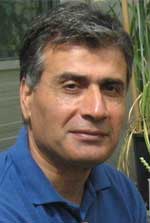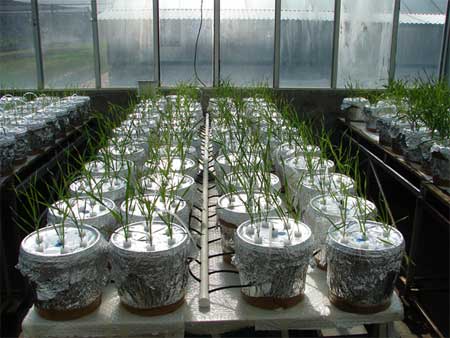Crawley, Western Australia
March 20, 2008
Researchers at
Institute of Agriculture,
The University of Western Australia (UWA), are supporting WA
wheat breeders and ultimately growers by characterising the
genetic and physiological traits of wheat that enable it to
tolerate high concentrations of aluminium, manganese and iron.
 With funding from the Australian Research Council (ARC) and the
Department of Agriculture and Food WA (DAFWA), Dr Hossein Saberi
(photo) and Professor Zed Rengel of the School of Earth and Geographical
Sciences and Institute of Agriculture, UWA, have developed
screening techniques for assessing the tolerance of different
wheat varieties to ion toxicity. With funding from the Australian Research Council (ARC) and the
Department of Agriculture and Food WA (DAFWA), Dr Hossein Saberi
(photo) and Professor Zed Rengel of the School of Earth and Geographical
Sciences and Institute of Agriculture, UWA, have developed
screening techniques for assessing the tolerance of different
wheat varieties to ion toxicity.
Dr Saberi said that with more than 2.5 million hectares of
acidic soils in cropping areas of WA and up to 1.7 million
hectares of soils that are periodically waterlogged, conditions
are created that allow ion toxicity to occur, reducing wheat
yield and quality.
According to the Australian National Resources Audit in 2006,
transient waterlogging affects one in four farms in the WA
grainbelt, causing up to 70 per cent yield loss in extreme
cases.
“Waterlogged soils are associated with a chemical process which
increases iron and manganese ion levels beyond plant nutritional
needs, leading to toxicity and poor plant growth,” Dr Saberi
said.
“Acid soils are associated with increased concentrations of
aluminium ions, which are also toxic to plants.”
Professor Rengel indicated that the identified variation will
help with understanding the genetics and physiology of wheat
tolerance to ion toxicity and characterising field sites for
future breeding trials.
The group has already identified useful variation for iron and
manganese toxicity tolerance among wheat breeding lines.
 |
|
Development and
optimisation screening technique used to
determine ion toxicity in wheat. |
|
Robin Wilson, Senior Wheat Breeder at wheat breeding company
InterGrain, a joint venture of DAFWA and the Grains Research and
Development Corporation, said the ion toxicity project would
provide valuable information to growers on the reaction of
traditional and new varieties to toxicity.
“It will also provide breeders with knowledge of wheat germplasm
tolerant to ion toxicity and therefore traits which could be
passed on through breeding,” he said.
“Further, identifying new lines with varying levels of ion
toxicity tolerance will enable researchers to define regions of
WA where it occurs and gain a clearer picture of how it can
affect wheat growing.
“Another desirable outcome of establishing tolerance to ion
toxicity is a better understanding of how wheat copes with
transient waterlogged conditions and this will help to develop
future breeding strategies,” Mr Wilson said. |
|